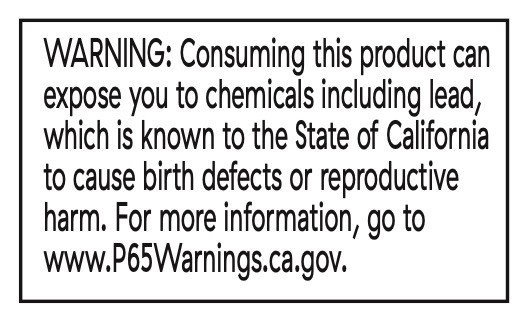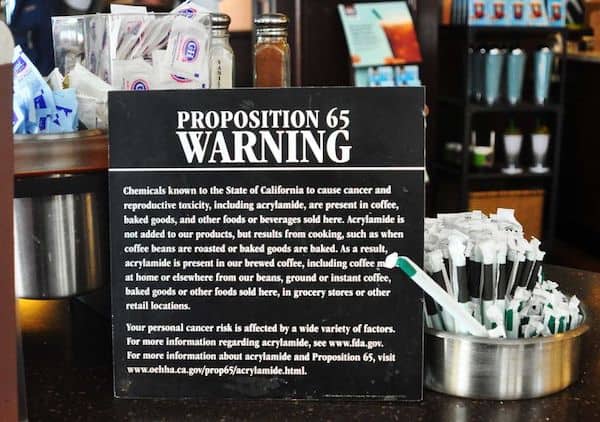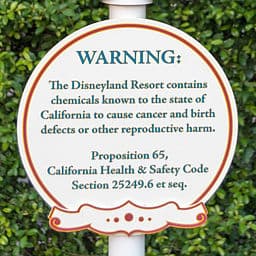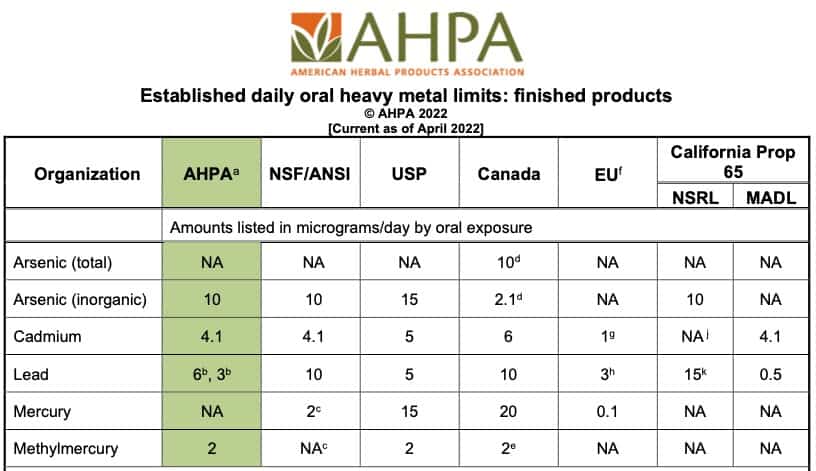Menu


The above is a common California Proposition 65 warning and is similar to the warning on some of our products.
If this gives you cause for concern, please read on and learn more about what this means.
At Real Mushroom, your health and the safety of our products is a primary concern and for this reason, every batch we make is tested extensively in order to meet all regulatory requirements, including heavy metals.
It is important to remember that almost all of the foods we eat on a daily basis contain very minuscule amounts of heavy metals. Mushrooms, like any other naturally grown fruits and vegetables, will absorb minerals and heavy metals from the substrate or soil in which they are grown.
As the 5th largest economy in the world, and a large consumer of natural products, California is an important market. Even though our products meet the Prop 65 guidelines, Real Mushrooms has decided to put a warning on our products to inform our consumers in California and to be in complete accordance with California Prop 65.
The presence of this warning does not mean the product is unsafe.
Alternatively, a product without this warning does not necessarily mean the product is safe.
Real Mushrooms has rigorous supply chain controls and robust testing programs to ensure the quality and safety of our mushroom extracts. Consistent with prudent industry practices, we routinely tests for Prop 65 listed chemicals of concern, including lead, cadmium, arsenic, and mercury. The allowable levels of these chemicals under Prop 65, however, are much lower than more widely recognized governing bodies.
All Real Mushrooms products meet Prop 65 guidelines for heavy metals.
Our products are consumed by tens of thousands of people daily and are recommended by thousands of health practitioners. If you have any concerns, please email us directly for certificates of analysis.
The California Safe Drinking Water and Toxic Enforcement Act of 1986, also called Prop 65, is an initiative that addresses citizen concerns about toxic chemical exposure.
Each year, California publishes a list of chemicals known to cause cancer, birth defects, or other reproductive harm. The act requires companies to place warning messages on their products if products contain amounts of any of the listed chemicals close to or over the limit. The chemicals are listed based on research from authoritative bodies summarized by the Office of Health Hazard Assessment (OEHHA 2019).
OEHHA has established No Significant Risk Levels, or Maximum Allowable Dose Levels for some chemicals; if chemical concentrations in products are under these, companies do not have to post warnings but many companies choose to do so to avoid potential litigation.
Prop 65 has come under much scrutiny however, due to the lack of scientific rigour involved in identifying chemicals, and setting allowable limits (Fischer 2016). Though well-meaning, the Act now functions more as a tool for lawyers than a consumer protection device, with small companies being sued over lack of labelling, even if their products did not pose any risk to consumers.

Coffee is now exempt from Prop 65 but previously any coffee shop in California needed to have a warning on their storefront because coffee contains acrylamide, which is a byproduct of the roasting process and a potential carcinogen. Needless to say, people did not drink less coffee.
Prop 65 warnings are seen throughout California in a wide range of settings such as restaurants, grocery stores, hotels, schools, hospitals, and on a variety of consumer products including dietary supplements. While Prop 65 only applies to California, given the rise of online sales, it is very hard for companies to create California specific labelling so it is very common to receive products outside of California that contain a Prop 65 warning.

These warnings are meant to inform the residents of California of potential exposure to chemicals but Prop 65 does not ban any chemicals from being in products.
Prop 65 applies to any business that sells in the state of California, including online sales.
While companies with fewer than 10 employees are omitted, if the company sells online, they are likely still accountable to Prop 65. This is because the employee count includes the entire supply chain so if they use 3rd party fulfillment or sell on online marketplaces like Amazon, the employees of those secondary companies count towards the total employee count.
Opponents of Prop 65 argue that its warning requirement imposes unnecessary and costly mandates on businesses, rather than serving the public health.
After 30 years, recent data issued by California’s Attorney General suggest that more than 70% of the money exchanged under Prop 65 in court settlements goes to law firms. (Chemistry World)
Prop 65 is updated on a yearly basis, and currently covers over 900 chemicals.

As you can see, the Prop 65 MADL limit for lead is 20 times lower than Health Canada and 25 times lower than the FDA (not shown but 12.5).
The allowable levels of these chemicals under Prop 65, however, are much lower than regulated by more widely recognized bodies.
Below you can find average results for heavy metals of concern in our products.
| Mushroom | Lead | Arsenic | Cadmium | Mercury |
|---|---|---|---|---|
| 5 Defenders | 0.33ppm | 0.37ppm | 0.32ppm | 0.01ppm |
| Chaga | 0.69ppm | 0.03ppm | 0.18ppm | 0.01ppm |
| Cordyceps | 0.04ppm | 0.04ppm | 0.11ppm | Undetectable |
| Lion's Mane | 0.11ppm | 0.06ppm | 0.11ppm | Undetectable |
| Reishi | 0.12ppm | 0.35ppm | 0.21ppm | 0.02ppm |
| Tremella | 0.06ppm | 0.08ppm | 0.12ppm | Undetectable |
| Turkey Tail | 0.45ppm | 0.65ppm | 0.38ppm | 0.01ppm |
Here are a few example certificates of analysis from our co-packers who follow Current Good Manufacturing Practises (cGMP) and are either NSF or SQF certified. Co-packer information has been redacted for privacy.
Health Canada has published the Canadian Total Diet Study which looked at trace elements, including lead, in many different foods from many different sources.
Of the 2500+ samples tested over 20 years, more than 2400 samples (~93.5%) contained lead above the limit of detection.
Here are a few examples of common foods that are over the Prop 65 limit for lead when a regular serving size is factored in.
| Lead Content (ppm) | |
|---|---|
| Canned Soup (14oz) | 5.79 |
| Canned Pinnapple (14oz) | 4.96 |
| Peaches (150g) | 2.25 |
| Organ Meat (100g) | 1.90 |
| Spinach (100g) | 1.44 |
| Celery (100g) | 1.25 |
| Wine (5oz) | 1.02 |
| Hard Cheese (100g) | 0.85 |
| Fresh white fish (100g) | 0.83 |
| Carrots (100g) | 0.83 |
| Grape Juice (5oz) | 0.73 |
| Shellfish (100g) | 0.61 |
| Rice & Bran style cereals (60g) | 0.49 |
| Peanut Butter (32g) | 0.19 |
Every single day, the food and beverages we are consuming contain trace elements, including lead.
Our chocolate products also carry cadmium warnings for Prop 65. Cacao trees grow around the equator in rich volcanic soil and the trees naturally absorb what is in the soil, including small amounts of cadmium and lead. Virtually all dark chocolate has these metals present to some degree. One of the benefits of cacao is that it is also very high in iron, which is a heavy metal vital for health, especially for women.
At Real Mushrooms, your health and the safety of our products is a primary concern and for this reason, every batch we make is tested extensively in order to meet all regulatory requirements, including heavy metals. Our products are consumed by tens of thousands of people daily and are recommended by thousands of health practitioners.
If you have any concerns, please email us directly for certificates of analysis.
Government of Canada. 2013. https://www.canada.ca/en/health-canada/services/environmental-workplace-health/reports-publications/environmental-contaminants/final-human-health-state-science-report-lead.html#a74 Accessed March 18, 2019.
Office of Environmental Health Hazard Assessment (OEHHA). 2019. https://oehha.ca.gov/proposition-65/how-chemicals-are-added-proposition-65-list Accessed March 18, 2019.
FDA. 2019. Lead in Food, Foodwares, and Dietary Supplements. https://www.fda.gov/food/foodborneillnesscontaminants/metals/ucm2006791.htm Accessed March 20, 2019.
Fischer, D.B. 2016. Proposition 65 Warnings at 30 – Time for a Different Approach, 11 Journal of Business and Technology Law 131. Available at: http://digitalcommons.law.umaryland.edu/jbtl/vol11/iss2/2
Rechtschaffen, C. 1996. The Warning Game: Evaluating Warnings Under California's Proposition 65. Ecology LQ, 23: 303-368.
United States Pharmacopeia (USP) and the National Formulary (NF). 2017.
http://www.usp.org/sites/default/files/usp/document/our-work/chemical-medicines/key-issues/232-40-35-1s.pdf Accessed March 18, 2019.
Chemistry World
https://www.chemistryworld.com/news/californias-prop-65-controversy-/1010164.article
Accessed March 20, 2019.
Health Canada - Quality of Natural Health Products Guide https://www.canada.ca/en/health-canada/services/drugs-health-products/natural-non-prescription/legislation-guidelines/guidance-documents/quality-guide.html